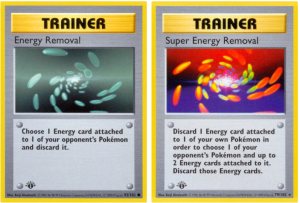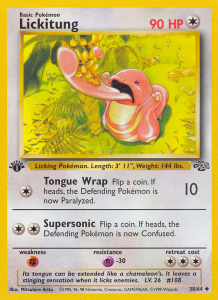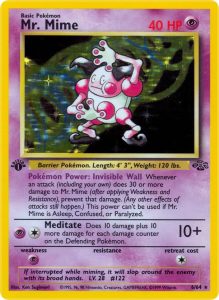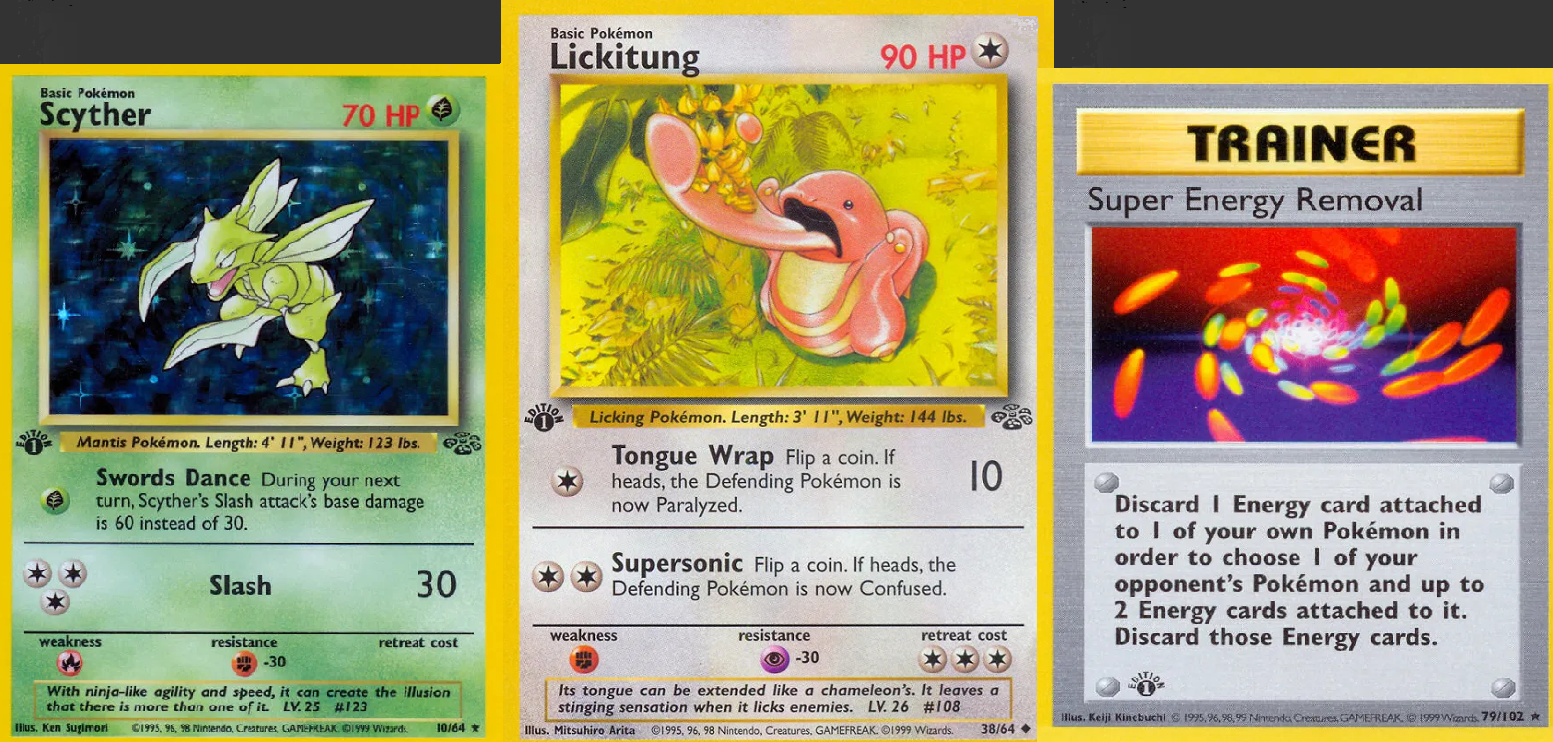When people talk about a “meta” in a game, they typically mean a collection of optimal strategies that dominate competitive results and/or the prevalence of certain strategies among a player base.
In Base Fossil if we talk of a meta, the core anchor of the way the game is played in 2025 (and as far as I can tell since around 2017+) is the “lickitung stall” deck archetype. While it’s not the only successful deck, its presence and dominance in the format also heavily determine what other decks are played at the top level (and what aren’t).
I think talking about this a bit helps explain and partly unlock the format for curious players interested to try the true first generation set of the pokemon TCG. If you want to understand and play base fossil well in 2025, you NEED to know at least how to play either against or with this deck to stand a chance. For better or worse, if you play base fossil, prepare to enter the warped world of Lickitung.
—-
In most tournaments of base fossil played today, expect to see these decks perhaps outnumber any other single deck type, and (on average) perform about as well as anything else or better. Wigglytuff decks and various haymaker-style decks typically also perform well, but the way these decks are usually built today (using Dodrio) are oriented towards competing with stall over a long game. Thus, Stall is the central animal in the base fossil ecosystem, and the other decks have to arrange their strategies around the challenge that Lickitung Stall creates.
—-
What makes “stall” so good in base fossil?
In short, I think the answer is a combination of the trainer cards available in base fossil and their synergy with certain pokemon (especially Lickitung), together driving win conditions away from easily taking 6 prizes and into a grindy resource battle that stall is best placed to win in the long run.
Let’s first talk victory conditions in base fossil. Take 6 prizes, steal a knockout win or win when your opponent decks-out. So far so normal… However, in most pokemon tcg formats, winning or losing by deck out is rare. Not so in base fossil: Expect many close games to end before 6 prizes are taken!
Among other reasons why, the format lacks many easy ways to slow the ticking clock of deck-out by putting cards back into the deck. The most used tools in the meta are LASS, MR FUJI, and GAMBLER, all of which play a role in putting off deck-out.
Alongside limited deck-out prevention cards, the format enables the incredible possibility of speedy draw should a player choose to use it. No supporter rules or turn 1 action limitations seen in later formats means some aggressive decks (through a combination of the use of OAK, BILL, COMPUTER SEARCH and ITEMFINDER) could draw through their entire deck in a turn or two. To try and get ahead in prizes some aggressive decks might draw through large amounts of their deck quickly, shortening their game to try and win quickly.
—-
Given fast draw potential though, if large attackers can be built easily through fast draw you might ask: surely 60 card decks should still have time to take 6 prizes even against stall decks?
That reckons without the staple cards of the format: Energy removal and Super Energy removal. These cards (which offer 100% reliable shut down of high energy attackers) slow the game down and prevent many expensive attackers even getting the chance to use their moves and thus take prizes, leaving efficient single energy attackers with control of the field.

To give you a practical sense of what this looks like: a typical Lickitung stall deck often plays 4 removal, 4 super energy removal and 3 or 4 item finder to be able to use the removal cards again if necessary…. As a result, expect any match against stall (or with it) which isn’t a lucky early knockout to be a drawn-out resource management war. Expect to have energy built up for any large attack removed quickly, and expect to struggle to even keep enough energy on the field to do more than chip damage your opponent.
—-
It’s time to talk about the pokemon that combine with these trainers to enable this meta.
Because of what we said about energy removal, basic pokemon with efficient attacks are the stars of the show in base fossil.
Hitmonchan and Electabuzz as “haymaker” were the original top deck in the era of base-set, providing decent HP basic pokemon which attacked efficiently. To begin with, this aggressive efficient combo paired with tons of powerful trainer cards to enable a rapid and aggressive play style aiming to take 6 prizes. So far so aggressive!
However when Jungle cards are added to the base set cards, the tempo changes.
Scyther and Lickitung both arrived in this set and based on the extensive experience the community has now, the synergy of these mons defensively (together with the trainer cards available) drive the meta to defensive/control deck superiority.
At 90hp Lickitung prevents almost any easy knockouts, with even super-effective Hitmonchan, only able to 3-shot lickitung without the aid of a pluspower (assuming it also hasn’t already lost turns paralyzed from Lickitung’s tongue wrap attacks).
This deep well of HP on a basic pokemon combined with a colourless attack for 10 with a 50/50 chance of paralysis (wasting the opponents next turn) makes most attacking decks unable to break through this pink wall fast enough before the Lickitung player can respond effectively.

A properly resourced Lickitung player will do their best to prevent you even taking the prize after all your effort damaging it, usually running 4 SCOOP UP to be able to remove Lickitung from the field and heal it of all damage.
An ideal set of stall moves might be: chip damage your enemy with your Lickitung. When Lickitung has received too much damage to safely remain on the field, use Super Energy Removal on the enemy utilising your 1 energy to remove 2 of theirs, before simply scooping up the damaged Lickitung, and replace it with a powered up Scyther from the bench. Boasting -30 fighting resistance against lickitungs most dangerous fighting type opponents (mainly Hitmonchan), Hitmonchan is then almost powerless to damage Scyther and struggles to retreat efficiently with 2 retreat cost. If it does find the energy or trainer cards to be retreated and replaced with a counter to Scyther, Scyther can later retreat for no energy cost (perhaps back to a fresh Lickitung!).

In this way, the fighting weak Lickitung and fighting resistant Scyther synergise with each other strongly and also with powerful base set trainer cards (Energy Removal, Super Energy Removal & Scoop Up) to survive and control the attacking power of most decks before fighting back efficiently.
Being only basic pokemon they also take up less deck space than evolution lines, enabling you to run both more basic pokemon (protecting you from dangerous mulligans & opponents knock-out attempts) or more deck space dedicated to the trainer cards that enable them to slow down and control a battle.
Chansey gives the deck another colourless basic pokemon card (with an even more whopping 120hp!) which enables further stalling ability and additionally the ability to do a huge 80 damage with double edge. Chansey often performs the role of a finisher for the deck, knocking out important targets that present a threat to the Lickitung/Scyther duo. 80 damage is enough to kill Dodrio, Wigglytuff or any big basic pokemon in one hit and almost KO fully the rare evolved pokemon like Blastoise and Venusaur which also see play and might otherwise present a threat to the core basics.

These three essentially colourless pokemon cards together with the powerful synergistic trainer cards of Energy Removal, Super Energy Removal and Scoop up provide the ability to survive, negate your opponents attacks and then counterattack effectively given the formats resource management and time scarcity.
Different flavours of Stall
As a postscript, stall decks can be constructed in many ways, given this (essentially) colourless core of Lickitung, Scyther & Chansey & the trainer cards that make up the defensive core of the deck.
Most commonly you see players playing “psy-stall” which put simply is the use of psychic energy and mons (in particular, Mr. Mime, Promo Mewtwo and Gastly) alongside the colourless stall “core”. These pokemon enable a large range of new flexible attacks and possibilities for the deck at the cost of running psychic energy. The flexibility and strength of these psychic pokemon make psy-stall the primary stall deck you will face, (and one of the safest choices to play to stand a chance at winning a skilful game of base fossil). Particular note should be given to Mr. Mime’s ability to stop large enemy pokemon in their tracks, unable to hurt Mr. Mime through its pokemon power, giving stall extra turns to find removal and counter play.

Alternatively to psy-stall, however, you can combine the colourless stall core cards with any other energy type available and then whatever corresponding pokemon that choice enables.
Other strong established stall decks are grass stall (running pure grass energy to enable Scyther to consistently use swords dance) and fire stall (enabling the flexible card fossil Magmar and perhaps Moltres to speed up your opponents deck out using wildfire).
For the curious out there, you could build other stall decks around Water or Electric or Fighting energy too – giving the stall core access to different pokemon along with their benefits and drawbacks.


Leave a Reply